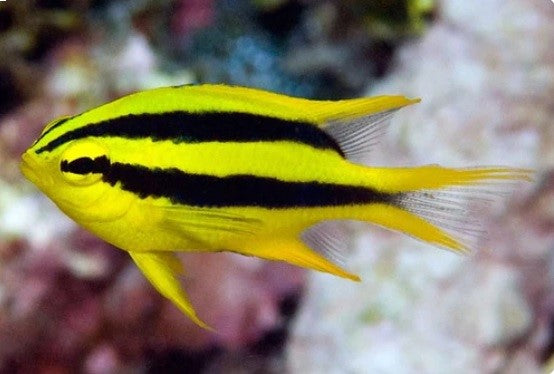| Black & Gold Chromis |
| CARE LEVEL | TEMPERAMENT | DIET |
REEF SAFE |
| Easy | Semi-Aggressive |
Omnivore |
Yes |
| PURCHASE SIZE | MAX SIZE |
ORIGIN |
TANK SIZE |
| APPROX 1" | 2.5" |
Indo, Solomon | 30g |
| SG |
TEMPERATURE |
dKH |
pH |
| 1.020-1.025 | 74-82F |
8-12 |
8.1-8.4 |
|
View Marine Fish Compatibility Chart Neoglyphidodon NigrorisNeoglyphidodon nigroris, also known as the Black & Gold Chromis is a striking marine species of Damselfish that captivates with its elegant contrast of colors and graceful movement. With a sleek body adorned in rich, velvety black hues accented by shimmering gold highlights, it exudes an aura of sophistication and allure. This damselfish typically boasts a slender, streamlined form, perfect for navigating through the intricate coral formations of its natural habitat. Its fins, outlined in glimmering gold, seem to dance effortlessly as it glides through the water, adding a touch of brilliance to its already captivating appearance. In aquarium settings, the Black & Gold Chromis Damselfish adds a touch of luxury and refinement to any marine display. Its striking coloration and peaceful demeanor make it a sought-after addition for both novice and experienced aquarists alike. Whether swimming gracefully amidst vibrant coral reefs or exploring the tranquil depths of a well-appointed aquarium, this enchanting species never fails to command attention and admiration. Growing up to 3 inches in length, these hardy fish are good for new and veteran reef chasers in a tank over 30 gallons. They are also a great choice for reef aquariums with invertebrates. Blue devil damselfish are also relatively easy to please with a variety foods. In the wild, they eat a variety of zooplankton, worms, brine shrimp, and copepods. They readily accept most frozen foods. Some blue devil damselfish will accept flake foods, but some may reject it. Damselfish, along with other fish, corals and invertebrates will also benefit greatly from Live Phytoplankton which is readily available to them in the wild. |
|
For more information about this species and more visit our Marine Fish Care Blog.
|

